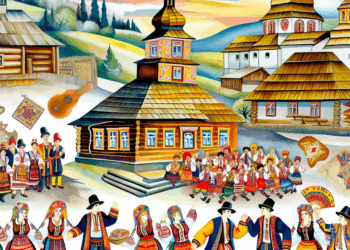Introduction
Bukovyna is a historical region located in north-western Ukraine and southern Romania. Throughout its history, this region has undergone many territorial changes and annexations, which have seriously affected its ethnic composition and cultural heritage. In this article we will look at the key events that led to changes in Bukovina’s borders in the 20th century, starting with its annexation to the Austrian Empire in 1775, its transition to Romania after World War I, its annexation by the USSR in 1940, and the formation of its current borders.
Austrian Empire (1775-1918)
In 1775, as a result of the partitions of Poland and the subsequent collapse of the Ottoman Empire, Bukovina was annexed by the Austrian Empire. This annexation was an important turning point for the region, marked by the increase of Germans, Ukrainians and Jews, who became the dominant ethnic groups.
After the annexation, Austria began active reforms to integrate the region into its imperial structure. By this time the centre of culture and education was concentrated in Chernivtsi, which became an important cultural and economic centre. A university was opened in the city, which contributed to the growing educated population.
At the end of the 19th century Bukovina, like other regions of the empire, began to feel the pressure of national movements. Romanian intellectuals began to actively promote the ideas of Romanian nationalism, which became a particular problem for the authorities of the Austrian Empire.
Romania (1918-1940)
With the end of World War I in 1918, Bukovina was ceded to Romania under the terms of the Treaty of Saint-Germain. This was a landmark event for the Romanian national movement, as Bukovina was an important region where significant Romanian ethnic groups were concentrated.
The transition to Romania led to changes in governance and socio-economic structure. Romanian authorities started a policy of Romanisation, which caused discontent among the non-Romanian population, especially Ukrainians and Jews. During this period, infrastructure, local self-government and culture were actively developed in the region. Moreover, Chernivtsi took an important place on the cultural map of Romania.
However, in 1940, the political situation in Europe changed again. As a result of the pressure of the Soviet Union and political agreements, much to Romania’s compulsion, Bukovina was again subject to territorial claims.
Soviet Union (1940-1941, 1944-1991)
In June 1940, as a result of the Soviet-Romanian Protocol on the Transfer of Territories, the eastern part of Bukovina was annexed to the USSR as part of a broad campaign to expand the Soviet Union’s borders to the west. This annexation was approved as a result of the “Tehran Accords” and authorised by international action.
The new Soviet government pursued a policy of “korenisation”, which meant the active involvement of the local population in administration and education. However, the majority of the population, especially Romanians and Ukrainians, faced repression and deportations.
With the outbreak of war in 1941, the territory of Bukovina was occupied by Nazi Germany and allied Romanian troops. At that time, mass crimes and ethnic cleansing took place on the territory of the region.
After liberation from the Nazis in 1944, the territory was rejoined to the USSR, which secured its status as part of the RSFSR and later the Ukrainian SSR.
Current borders and heritage
After the collapse of the Soviet Union in 1991, Bukovina was divided between two states: the western part became part of Romania, while the eastern part remained in Ukraine as part of Chernivtsi Oblast. This division consolidated the existing ethnic and cultural differences that had emerged during the centuries-long history of the region.
Within its current borders, Bukovyna remains an important cultural bridge between Ukraine and Romania. Both sides respect the historical vulnerabilities of the region and continue to co-operate on cultural exchange and economic co-operation.
Conclusion
The history of Bukovyna in the 20th century is a story of change and conflict. From its annexation by the Austrian Empire in 1775 to the present day, the region has been the forefront of many transformations that have affected its identity and population. Yet, despite changes in borders and authorities, Bukovina remains an important symbol of cultural heritage and diversity, reflecting a rich history of interaction between different peoples and traditions.








